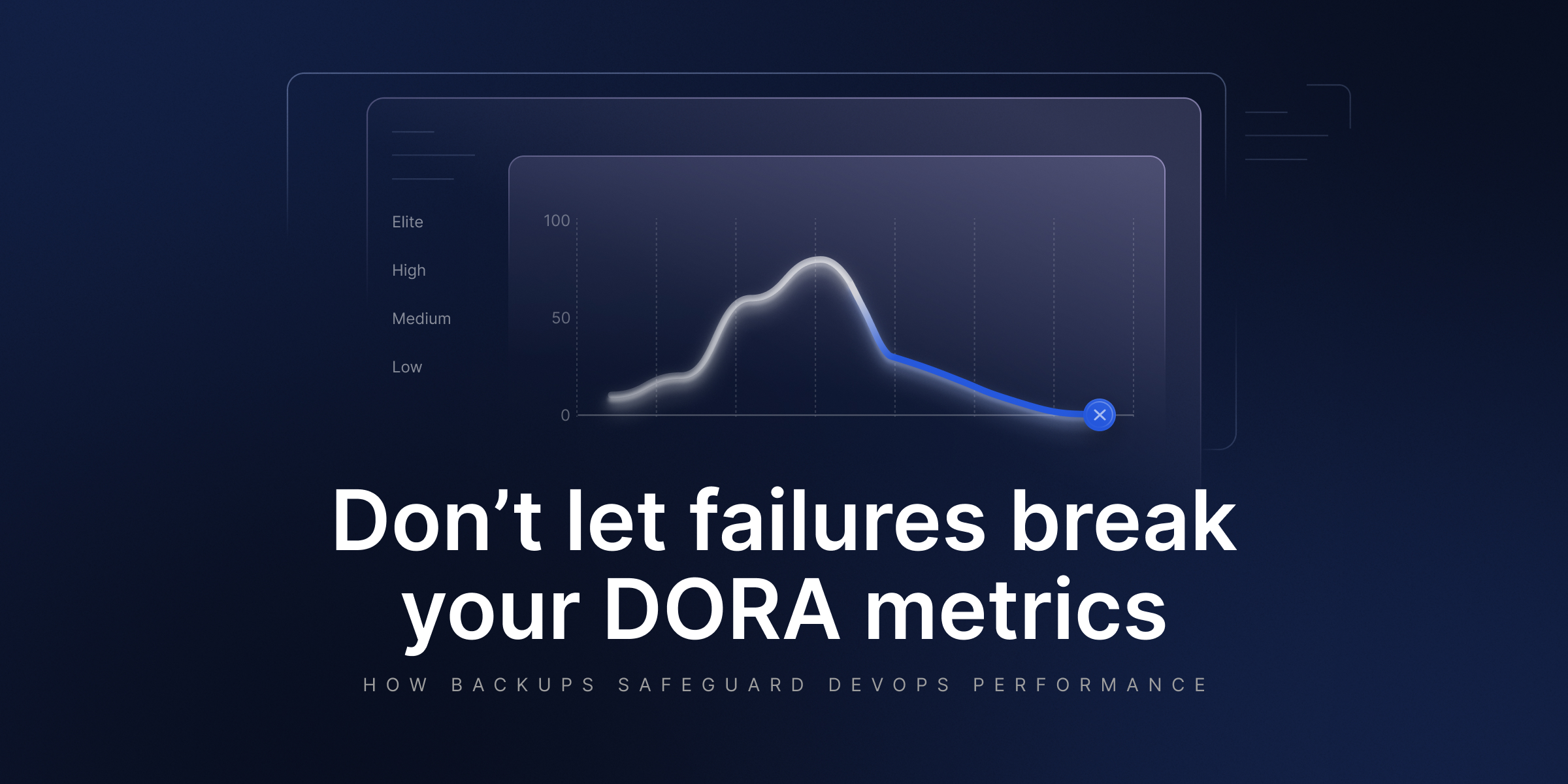
Don’t Let Failures Break Your DORA Metrics: How Backups Safeguard DevOps Performance
If you are a part of the DevOps community, you may have heard of DORA metrics. These were introduced to allow organizations to track and measure performance, so that they can further improve their software delivery life cycles. Over the years, the DevOps Research and Assessment (DORA) team proposed four metrics to drive the performance of SDLCs:
- Frequency of deployments
- The amount of time between acceptance and deployment
- How frequently deployments fail (change failure rate)
- Time to recover from a failure / restore the service
These four key metrics shall never be disregarded. Remember – DORA metrics measure information regarding your development and operations processes. In turn, these DORA metrics provide you with control over security, but you also get to monitor for improvement and potential optimization.
What is deployment frequency?
Deployment frequency is probably the most straightforward part of the DORA metrics and that is because it shows you how often your engineering team is shipping code to production.
Essentially, as a statistic, it reflects how many times on average your daily finished code deployments are shipped to any given environment. Now, this metric can give you the ability to instantly verify how fast your team is going.
We could agree that high-performing teams release on demand. Even several times a day! Whereas average teams with general lower performance release monthly or, in some cases, less often. More frequent and smaller releases can decrease security risks along with vulnerabilities, speed up feedback cycles, as well as allow organizations to react more quickly to the needs of their customers.
The importance of lead time for changes
This next one of DORA metrics indicates the actual amount of time it takes for code to move from commit to production. Believe it or not, tracking deployment frequency is one of the most revealing DORA metrics in regards to how effective and mature your software delivery process actually is. Simply put, lead time for changes reflects how quickly your teams can take just an idea and transform it into a feature or a fix for their users. Keep this in mind though, high-performing teams deploy frequently without risking quality.
Therefore, the shorter the lead time for changes, the more quickly your team can respond to customer feedback, debug, and deploy any necessary improvements. With DORA metrics, high performing DevOps teams shrink lead times from weeks or days down to hours but most importantly, they do it without sacrificing quality.
Look out for the change failure rate
Let’s move on to the change failure rate part of DORA metrics. It can provide you with insights into the frequency of deployments to production that actually fail. Keep in mind that with every deployment, there’s risk, and so this measure tells you how well your devops and engineering teams are managing and mitigating any potential risks encountered on the way.
If failures keep coming back in your reports and processes, this can signal things like:
- pipelines being too complex
- weak testing
- rushed reviews
On the other hand, what would a low failure rate mean? Well, stability and confidence in your own DevOps processes (provided you are still committing and delivering at a proper pace). The change failure rate of DORA metrics should help you guarantee that this speed of work is not breaking anything across your systems or procedures within the entire software delivery process.
Time to restore service – time to recovery
Last but not least, take a look at the time to restore service (or mean time to recovery – MTTR). It is one of the DORA metrics showing how quickly your teams can recover from a production failure. It does not matter if it is caused by a buggy deployment or an infrastructure issue; incidents tend to happen, and we need to secure our data before they take place. However, the important question is: how long does it take your organization to get back on track, restore service and return to its main business objectives?
Now, short recovery times reflect maturity across processes implemented. What they indicate is that your team has already achieved well-established incident response procedures, recovery steps, and can actually handle stressful situations. As for longer recovery windows… These could mean lost revenue and a bad user experience, along with poor customer trust.
The benefits of using DORA metrics
In DevOps environments, you will need a proper overview of your software delivery performance. Now, this is where you implement DORA metrics. With these four key metrics mentioned above, you can upgrade your processes thanks to these measurable insights into your SDLC. This way, you can safely speed up your processes without corrupting reliability, empower your development and operations teams as well as engineering leaders. Therefore, more successful DevOps teams use DORA metrics as they help to help to verify the software delivery performance, measure deployment frequency or even identify bottlenecks.
Progress and engineering initiatives evaluation
When you implement DORA metrics, elite teams and their engineering leaders can pinpoint useful key measurements. By analyzing engineering metrics, you can have a clear understanding of the return on investment (ROI). Moreover, you get to verify team performance and the impact of any company initiatives like network upgrades or infrastructure changes.
Improve dev experience with performance trends
As you may know, DORA metrics allow DevOps teams to spot any issues with CI/CD, code repos, staging, and quality checks tasks, or any other given software development process or tool. Now, if we just go back, changing failure rates along with lead time for changes can prove helpful. These offer your teams a road map of sorts to improve overall developer response time and help them resolve issues.
Take advantage of DORA metrics best practices
Let’s focus on why DORA metrics play a role in DevOps security. Well, that’s due to measurements that can be quantified and then further evaluated and applied to processes. It is like going through and checking your work for improvements with an ace up your sleeve to help you do it more precisely and efficiently to support your development teams.
You are most likely aware that these are the characteristics of complete DevOps and engineering teams:
- high-quality changes
- faster results
- less frequent failures
- reduced data recovery time
It’s important to locate areas for improvement, as well as spot processes that work and apply them to other relevant procedures or DevOps teams in order to drive your primary business objectives.
Can backup and DR help with risk mitigation?
While there is never a single fix to a problem, backup, along with disaster recovery capabilities, covers a vast area of your cyberdefenses that benefits data protection. Especially, since we are talking about frequent and quality deployments, leading to a need for frequent backups. If these could be scheduled and automated in a flexible manner, that is time saved for your teams and a security boost, as this would eliminate the need for human intervention. Treat this as an integral aspect working in synchrony with DORA metrics.
Now, if you took care of aligning practices with DORA metrics, you take care of scheduling and automation, the next step is to guarantee appropriate restore and recovery options. A great idea would be to implement a solution with granular and point-in-time restore capabilities, as frequent deployments and changes could potentially require you to go back and restore files that turned out to be needed. This is where retention comes in, too; you want unlimited retention as you never know when you may need a piece of deleted code.
To further improve software delivery and implement DORA metrics you shall include proper AES encryption and keep your data protected both at rest and in-flight. Complete backup & DR solution will definitely provide comprehensive monitoring and alerting options as well as support your compliance efforts.
Conclusion
To sum up, the DevOps Research and Assessment (DORA) is a set of metrics to help organizations improve their DevOps processes. You can easily track team performance, progress, stability, delivery speed, and so on. However, there is one thing to keep in mind. These metrics are helpful, but you still need to implement proper security measures. So, your ability to recover from a security incident or any other issue is critical – make sure to introduce effective backup and disaster recovery procedures in order to apply these metrics properly. Implementing the DORA metrics can help you drive continuous improvement, facilitate proper lead time for changes, collect data regarding engineering performance, production change failure rate, and general operational performance, as well as improve the low-performing teams.
[FREE TRIAL] Ensure compliant DevOps backup and recovery with a 14-day trial 🚀
[CUSTOM DEMO] Let’s talk about how backup & DR software for DevOps can help you mitigate the risks






